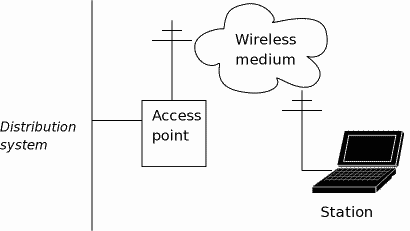WLAN
Introduction
The Wireless Local Area Network standard evolved in 1997 in form of the IEEE 802.11 Protocol.
The standard family concerns the physical and data link layers as defined by the Open Systems Interconnection (OSI) Reference Model.
It describes how to use radio frequencies (RF: typically in the microwave spectrum around 2.4 / 5 G-Hz, so called ISM bands)
as transmission medium to build a local area network. It also includes an infra-red technique for data-transmission.
This means we have two spread-spectrum methods for radio frequencies and one method for infra-red.
The Range depends on the used antennas (omnidirectional vs. high gain fixed point): 50m up to 8km.
Nomenclature
WLANs consist of at least one basic service set (BSS). This might be only two or more computational devices with wireless network interfaces (stations) or a group of stations communicating through an access point (AP), which can act additionally as a router to another network.
In the first case it is called an independent bss or ad-hoc bss, in the second, an infrastructured bss.
If more BSS are connected together this is called an extended service set (ESS). Usually the APs work as a bridge between the wireless network and a (not necessarily wired) backbone.
The logical mechanism, that forwards the frames to their destination is called distribution system.
Provided Functionality
Using RF as transmission medium request special procedures to warrant access by multiple machines. Error rates in wireless communication is significant high and connection quality varies, beside that there's no guarantee that all participants of a network realize each others communication. (Hidden Node Problem). Therefore specific kind of Collision Avoidance (CSMA/CA) and Error Handling has to be done.
The Media Access Control provides asynchronous data service.
A general MAC Frame consists of:
- a MAC header (with frame control, duration, address and sequence control information)
- a frame body containing information depending on frame type
- a frame check sequence containing cyclic redundancy code
(Frame Control)(Duration ID)(Addr. 1)(Addr. 2)(Addr.3)(Sequence Control)(Addr. 4) (Frame Body)(FCS)
After each transmission sender expects to get acknowledge from receiver(positive acknoledment),
to realize everything went correctly.
This also means that the sending station has to do the error recovery part.
Access is coordinated through Distributed Coordination Function (DCF; see CSMA/CA) that checks whether the radio link is clear before sending.
Short Ready To Send / Clear To Send (RTS/CTS) frames and a random backoff time might be used to reserve aether for the process of transmission.
Security
For security issues the standard contains the
Wired Equivalent Privacy (WEP) substandard
based on RC4 algorithm (encryption with 40 / 104 Bits).
It was enhanced / replaced by Wifi Protected Access (WPA).
